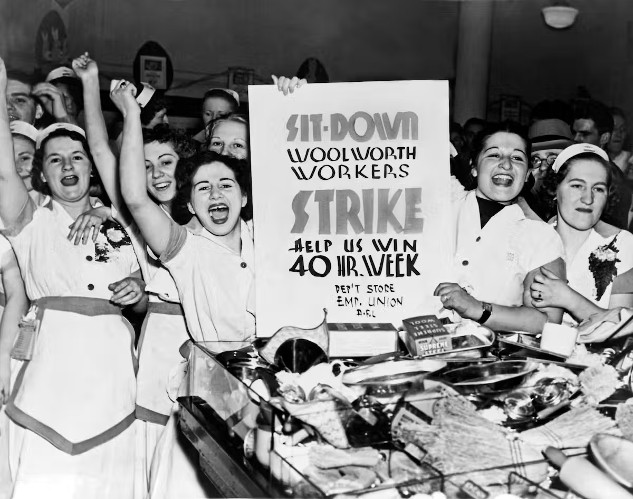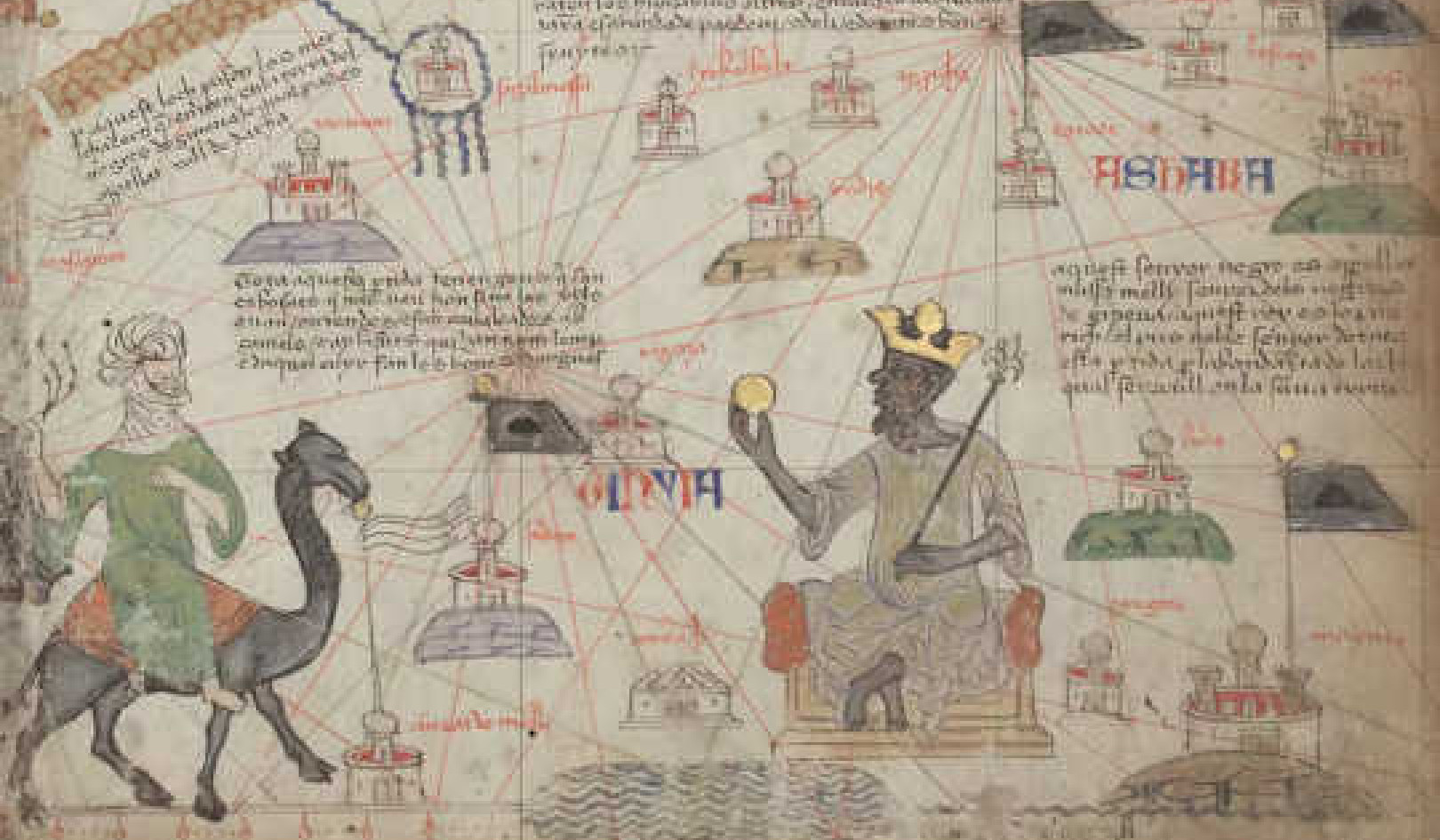 Woolworth’s employees strike for a 40-hour workweek in 1937. Underwood Archives/Getty Images
Woolworth’s employees strike for a 40-hour workweek in 1937. Underwood Archives/Getty Images
There have been massive gains in productivity over the past century.
So why are people still working so hard for so long?
Output per worker increased by almost 300% between 1950 and 2018 in the U.S. The standard American workweek, meanwhile, has remained unchanged, at about 40 hours.
This paradox is especially notable in the U.S., where the average work year is 1,767 hours compared with 1,354 in Germany, a difference largely due to Americans’ lack of vacation time.
Some might argue that Americans are just more hardworking. But shouldn’t more productive work be rewarded with more time free from work?
This is the central theme of my new book, “Free Time: The History of an Elusive Ideal.”
Keynes misses the mark
Many economists see the status quo mostly as a choice: People would simply rather have more money. So they prioritize work over free time.
However, in the past, many economists assumed that people’s need for more stuff would eventually be met. At that point, they would choose more free time.
In fact, one of the most famous economists of the 20th century, John Maynard Keynes, confidently predicted in 1930 that within a century, the normal workweek would decrease to 15 hours. Yet Americans in their prime working age are still on the job 41.7 hours per week.
Why was Keynes wrong?
Obviously, people’s needs or wants were not fully met. In the first half of the 20th century, advertising shifted in ways that emphasized emotions over utility, making consumers feel like they needed to buy more stuff; planned obsolescence shortened how long products remained functional or fashionable, spurring more frequent purchases; and new, exciting – but costly – goods and services kept consumerism churning.
So workers continued to labor for long hours to earn enough money to spend.
Furthermore, as wages rose, the opportunity cost of time spent away from work also grew. This made more free time less economically appealing. In a consumption-saturated society, time spent neither producing nor consuming goods increasingly appeared as wasted time.
Interest in slower, cheaper activities – reading a book, meeting a friend to catch up over coffee – started to seem less important than buying a pickup truck or spending an hour at the casino, pursuits that demand disposable income.
Forced labor
It’s still important to consider whether there’s even any choice to be made.
Almost everyone who works 40 hours a week or more does so because they have to. There are bills to pay, health insurance coverage to maintain and retirement to squirrel away money for. Some jobs are more precarious than others, and many workers even forego earned vacation time for fear of losing promotions.
This hardly makes for a free choice.
But the 40-hour week isn’t the result of a personal calculation of costs and benefits. Rather, it’s the result of a hard-fought political battle that culminated in the Fair Labor Standards Act of 1938, which established the standard 40-hour workweek, along with a minimum wage.
Pressed by a labor movement that was far more powerful than today’s, the government implemented a range of progressive economic policies during the 1930s to help the nation emerge from the Great Depression.
Many government officials viewed setting a standard workweek as a way to curtail exploitation and unfair competition among employers, who would otherwise be motivated to push their employees to work for as long as possible. It was an emergency measure, not a choice of more time over more personal income. Nor was it a step toward the progressive reduction of hours worked, as Keynes had envisioned.
In fact, it was hardly a radical measure.
Labor leaders had initially proposed a 30-hour week, which government officials resoundingly rejected. Even New Deal liberals saw a shortening of working hours as a potential threat to economic growth.
So the 40-hour week ended up as the compromise, and the standard hasn’t been updated since.
For most Americans, this was an acceptable trade-off. They might be working long hours, but they could afford television sets, cars and homes in the suburbs. Many families could live on the wages of the full-time work of the father, making the 40-hour week seem reasonable, since the mother had time to care for the family and home.
But this consensus has long since been undermined. Since the 1970s, inflation-adjusted wages haven’t risen with economic growth. In many households that include married or partnered couples, a single wage earner has been replaced by two earners, both of whom find themselves working at least 40 hours per week.
It’s almost as if the 40-hour week has been replaced by an 80-hour week – at least in terms of hours worked per household.
Who has time to raise kids? Who can afford them? It’s no wonder the birth rate has declined.
Separating economic growth from well-being
For decades, the amount of work we do has been talked about as “just the way things are” – an inevitability, almost. It doesn’t seem possible for society to take a different tack and, like flipping a switch, work less.
To me, this resignation points to a need to reconsider the social contracts of the past. Most Americans will not abandon their work ethic and their insistence that most people work. Fair enough.
Many people prefer working over having vast stores of free time, and that’s OK. And there’s still immense value in work that doesn’t produce a paycheck – caregiving and volunteering, for example.
But reducing the standard workweek, perhaps by transitioning to a four-day week, could ease stress for overworked families.
These changes require political action, not just individuals making the personal choice to arrive at a better work-life balance. And yet a national reduction in the standard workweek seems almost impossible. Congress can’t even pass legislation for paid family leave or guaranteed vacation time.
It doesn’t help that elected leaders continue to insist that well-being be measured mostly by economic growth, and when the U.S. media breathlessly reports quarterly economic growth data, with increases deemed “good” and decreases deemed “bad.”
Why shouldn’t free time and its benefits be included in the equation? Why aren’t figures on the social costs of unlimited growth publicized? Does it even matter that the Dow Jones Industrial Average has doubled in less than a decade when economic security is so fragile and so many people are overstressed?
The idea that stratospheric increases in productivity can allow for more time for life is not simply a romantic or sentimental idea. Keynes viewed it as entirely reasonable.
Opportunities like the one that led to the 40-hour workweek in the 1930s rarely appear. But some sort of paradigm shift is urgently needed.
Something has to give.![]()
Gary Cross, Distinguished Professor of Modern History, Penn State
This article is republished from The Conversation under a Creative Commons license. Read the original article.
Books on Inequality from Amazon's Best Sellers list
"Caste: The Origins of Our Discontents"
by Isabel Wilkerson
In this book, Isabel Wilkerson examines the history of caste systems in societies around the world, including in the United States. The book explores the impact of caste on individuals and society, and offers a framework for understanding and addressing inequality.
Click for more info or to order
"The Color of Law: A Forgotten History of How Our Government Segregated America"
by Richard Rothstein
In this book, Richard Rothstein explores the history of government policies that created and reinforced racial segregation in the United States. The book examines the impact of these policies on individuals and communities, and offers a call to action for addressing ongoing inequality.
Click for more info or to order
"The Sum of Us: What Racism Costs Everyone and How We Can Prosper Together"
by Heather McGhee
In this book, Heather McGhee explores the economic and social costs of racism, and offers a vision for a more equitable and prosperous society. The book includes stories of individuals and communities who have challenged inequality, as well as practical solutions for creating a more inclusive society.
Click for more info or to order
"The Deficit Myth: Modern Monetary Theory and the Birth of the People's Economy"
by Stephanie Kelton
In this book, Stephanie Kelton challenges conventional ideas about government spending and the national deficit, and offers a new framework for understanding economic policy. The book includes practical solutions for addressing inequality and creating a more equitable economy.
Click for more info or to order
"The New Jim Crow: Mass Incarceration in the Age of Colorblindness"
by Michelle Alexander
In this book, Michelle Alexander explores the ways in which the criminal justice system perpetuates racial inequality and discrimination, particularly against Black Americans. The book includes a historical analysis of the system and its impact, as well as a call to action for reform.






















